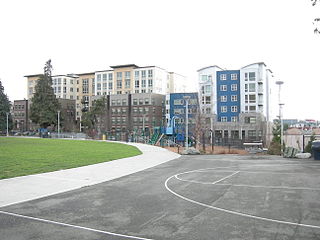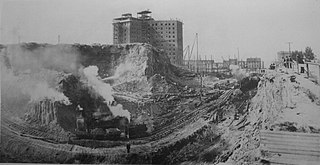Related Research Articles
History of Seattle, Washington 1900–1940
Two conflicting perspectives exist for the early history of Seattle. There is the "establishment" view, which favors the centrality of the Denny Party, and Henry Yesler. A second, less didactic view, advanced particularly by historian Bill Speidel and others such as Murray Morgan, sees David Swinson "Doc" Maynard as a key figure, perhaps the key figure. In the late nineteenth century, when Seattle had become a thriving town, several members of the Denny Party still survived; they and many of their descendants were in local positions of power and influence. Maynard was about ten years older and died relatively young, so he was not around to make his own case. The Denny Party were generally conservative Methodists, teetotalers, Whigs and Republicans, while Maynard was a drinker and a Democrat. He felt that well-run prostitution could be a healthy part of a city's economy. He was also on friendly terms with the region's Native Americans, while many of the Denny Party were not. Thus Maynard was not on the best of terms with what became the Seattle Establishment, especially after the Puget Sound War. He was nearly written out of the city's history until Morgan's 1951 book Skid Road and Speidel's research in the 1960s and 1970s.

The street layout of Seattle is based on a series of disjointed rectangular street grids. Most of Seattle and King County use a single street grid, oriented on true north. Near the center of the city, various land claims were platted in the 19th century with differently oriented grids, which still survive today. Distinctly oriented grids also exist in some cities annexed by Seattle in the early 20th century, such as Ballard and Georgetown. A small number of streets and roads are exceptions to the grid pattern.

The Denny Triangle is a neighborhood in Seattle, Washington, United States, that stretches north of Downtown Seattle to the grounds of Seattle Center. Its generally flat terrain was originally a steep hill, taken down as part of a mammoth construction project in the first decades of the 20th century known as the Denny Regrade, which is another name for the neighborhood on the regraded area. The name Denny Triangle, referring to the northeastern portion of this regrading project, is a term that has gained currency as this neighborhood has seen increasing development in the first decades of the 21st Century.

Queen Anne is a neighborhood and geographic feature in Seattle, Washington, United States, located northwest of downtown. Queen Anne covers an area of 7.3 square kilometers (2.8 sq mi), and has a population of about 28,000. It is bordered by Belltown to the south, Lake Union to the east, the Lake Washington Ship Canal to the north and Interbay to the west.

Denny Park is a park located in the South Lake Union neighborhood of Seattle, Washington. It occupies the block bounded by John Street and Denny Way on the north and south and Dexter and 9th Avenues N. on the west and east.

Cascade is an urban neighborhood abutting Downtown Seattle, Washington, United States, located adjacent to South Lake Union. It is bounded by: Fairview Avenue North on the west, beyond which is the rest of the Cascade Neighborhood; the Interstate 5 interchange for Mercer St to the north, beyond which is Eastlake; Interstate 5 on the east, beyond which is Capitol Hill; and Denny Way on the south, beyond which is Denny Triangle. It is surrounded by thoroughfares Mercer Street (eastbound), Fairview Avenue N. and Eastlake Avenue E., and Denny Way. The neighborhood, one of Seattle's oldest, originally extended much further: west to Terry Avenue, south to Denny Hill on the South, and east to Melrose Avenue E through the area now obliterated by Interstate 5. Some recent writers consider Cascade to omit the northern "arm", while others extend it westward to cover most of South Lake Union.

Yesler Terrace is a 22-acre (8.9 ha) public housing development in Seattle, Washington, United States. It was completed in 1941 as the state's first public housing development and the first racially integrated public housing development in the United States. It occupies much of the area formerly known as Yesler Hill, Yesler's Hill, or Profanity Hill. The development is administered by the Seattle Housing Authority, who have been redeveloping the neighborhood into a mixed-income area with multi-story buildings and community amenities since 2013.

Princess Angeline, also known in Lushootseed as Kikisoblu, Kick-is-om-lo, or Wewick, was the eldest daughter of Chief Seattle.

Reginald Heber Thomson was a self-taught American civil engineer. He worked in Washington state, mainly in Seattle, where he became city engineer in 1892 and held the position for two decades. Alan J. Stein wrote that Thomson "probably did more than any other individual to change the face of Seattle" and was responsible for "virtually all of Seattle's infrastructure".

Cherry Hill is a predominantly residential area in Seattle, Washington located south of Capitol Hill within the Central District, north of the International District, and east of First Hill. Cherry Hill is bound on the west by 14th Avenue, on the east by 23rd Avenue, on the north by East Madison Street and on the south by East Yesler Way. Cherry Hill overlaps considerably with the neighborhood of Squire Park as defined by the Squire Park Neighborhood Council. In the Seattle City Clerk's Geographic Indexing Atlas, Cherry Hill is designated as the Minor neighborhood of the Central Area. Cherry Hill was previously called Second Hill or Renton Hill.

The topography of central Seattle was radically altered by a series of regrades in the city's first century of urban settlement, in what might have been the largest such alteration of urban terrain at the time.

David Thomas Denny was a member of the Denny Party, who are generally collectively credited as the founders of Seattle, Washington, USA. Though he ultimately underwent bankruptcy, he was a significant contributor to the shape of the city. Roger Sale, in his book Seattle, Past to Present, described him as having been "the pioneer to turn to if one had a plan that would be 'good for Seattle', and one needed a respectable tone and a willing investor."

The First Hill Streetcar, officially the First Hill Line, is a streetcar route in Seattle, Washington, United States, forming part of the modern Seattle Streetcar system. It travels 2.5 miles (4.0 km) between several neighborhoods in central Seattle, including the International District, First Hill, and Capitol Hill. The line has ten stops and runs primarily in mixed traffic on South Jackson Street and Broadway.

Broadway is a major north–south thoroughfare in Seattle, Washington. The 1.6-mile-long (2.6 km) arterial runs north from Yesler Way at Yesler Terrace through the First Hill and Capitol Hill neighborhoods to East Roy Street. Broadway East continues north to East Highland Drive. North of there the street is made up of shorter segments: one from just south of East Blaine Street to just north of East Miller Street, another from East Roanoke Street to East Shelby Street, and the last from East Allison Street to Fuhrman Avenue East.

Glacial erratic boulders of King County are large glacial erratic boulders of rock which were moved into King County, Washington by glacial action during previous ice ages.
Many glacial erratic boulders can be found in the Puget Sound region as far south as the Yelm area where the Puget Lobe of the glacier reached its maximum extent.

Pike Street is an east-west street in Seattle. It extends from Pike Place above Seattle's saltwater waterfront at Elliott Bay through Downtown Seattle, across Capitol Hill to the freshwater shore of Lake Washington at Lake Washington Boulevard. A segment less than a block long exists at Alaskan Way on Elliott Bay, connected to the rest of the street only by the pedestrian Pike Street Hill Climb; the bottom of the hillclimb under the Alaskan Way Viaduct was the original shoreline of the city before major modification and construction of the Seattle Seawall. It is included in the south-to-north mnemonic "Jesus Christ Made Seattle Under Protest" for the street layout of Seattle.
Denny Way is an east–west arterial street in downtown Seattle, Washington, United States. It forms the northern end of the Belltown street grid as well as the boundaries of Belltown, Lower Queen Anne, South Lake Union, Denny Triangle, and Cascade. The street continues east through Capitol Hill to Madrona as a minor neighborhood street, ending near Madrona Park on Lake Washington.
References
- Hugh Ferriss (1953). Power in Buildings: An Artist's View of Contemporary Architecture. Columbia University Press. p. 22. ISBN 9780598382313. LCCN 53012306.
- Walt Crowley (January 14, 2003), "Seattle's Seven Hills", HistoryLink , Seattle: History Ink
- Seven Hills Park, Seattle Parks and Recreation, retrieved 2013-10-24
- Seven Hills Park (formerly Capitol Hill Park) development Pro Parks project information: Boulders plan (PDF), Seattle Parks and Recreation/Mithun, Inc, August 23, 2010, archived from the original (PDF) on December 25, 2019, retrieved 2013-10-24
- Greg Johnston (November 13, 2008), "FANTASTIC FOUR: STRING TOGETHER THESE EMERALD PARKS FOR A GEM OF AN URBAN HIKE", Seattle Post-Intelligencer , p. 10 – via ProQuest
- Williams, Hill (October 2, 1989), "SCIENTISTS FIND OLD DENNY HILL - AT BOTTOM OF PUGET SOUND", The Seattle Times , p. C1 – via ProQuest
- David Wilma (October 12, 2005), "Seattle annexes the area north of N 85th Street to N 145th Street on January 4, 1954", HistoryLink , Seattle: History Ink
- "Seven Hills? One Capitol Hill park gets its 'official' name", The Seattle Times (Local), retrieved 2013-10-24
- "2011 Summer Guide: May events — Seven Hills Walk", The Seattle Times , May 18, 2011
- Join Sound Steps/Seattle-Bergen Sister City Association for the 9th Annual Seven Hills Walk, Seattle Parks and Recreation, May 2, 2012, retrieved 2013-10-24
- "Seven Hills of Seattle walk with the Seattle-Bergen Sister City Association", Norwegian American Weekly, June 2, 2009, retrieved 2013-10-24
- "Community celebrates Myrtle Reservoir Park", Press release, City of Seattle, April 25, 2011, archived from the original on November 5, 2013 – via HighBeam (subscription required)
- Nelson, Richard (July 15, 1990), "Rite of Northwest Passage THE GOOD RAIN Across Time and Terrain in the Pacific Northwest by Timothy Egan (book review)", The Los Angeles Times – via ProQuest
- Geology of Seattle and the Puget Sound on YouTube, narrated by Nick Zentner (Central Washington University Department of Geological Sciences). Uploaded March 2, 2015 by Hugefloods.com (Nick Zentner and Tom Foster: Discover the Ice Age Floods).
- Troost, Kathy Goetz; Booth, Derek B. (2008), Geography of Seattle and the Seattle area, Washington, Geological Society of America, doi:10.1130/2008.4020(01), ISBN 9780813741208